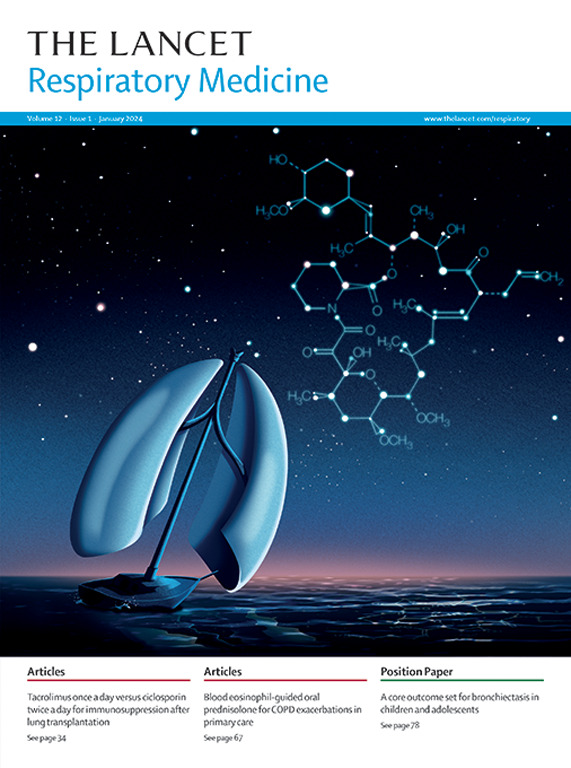吗啡治疗慢性呼吸困难(MABEL)在英国:一项多地点,平行组,剂量滴定,双盲,随机,安慰剂对照试验
IF 32.8
1区 医学
Q1 CRITICAL CARE MEDICINE
引用次数: 0
摘要
在实验室研究中发现的阿片类药物治疗呼吸困难的有效性尚未在临床试验中得到证实。我们的目的是评估口服吗啡治疗长期呼吸困难的有效性。该3期、平行组、双盲、安慰剂对照试验在11个中心进行,随机分配同意的成年人(1:1,按地点和病因分层),经修改的医学研究委员会(Medical Research Council)呼吸困难评分为3分或以上,由于心肺疾病,接受5-10毫克口服长效吗啡或安慰剂(以及盲法泻药),为期56天。主要结果是在第28天过去24小时的最严重呼吸困难评分,使用数值评定量表(NRS; 0=完全不呼吸;10=可想象的最严重呼吸困难)进行测量。次要结局包括身体活动水平、最严重咳嗽NRS、生活质量和吗啡相关毒性。接受至少一剂研究药物的患者有资格纳入疗效和安全性分析。该试验已在ISRCTN (ISRCTN87329095)和EU临床试验注册(EudraCT 2019-002479-33)注册。在2021年3月18日至2023年10月26日期间,143名参与者被随机分配接受吗啡(73名参与者)或安慰剂(67名参与者),并被纳入分析;三名参与者没有接受分配的治疗。参与者平均年龄为70.5 (SD 9.4)岁,大多数为男性(93[66%]),大多数为白人(132[94%])。到第28天,吗啡组的64名(88%)参与者与安慰剂组的66名(99%)参与者有90%或更高的依从性。在第28天,我们没有发现最严重呼吸困难的证据差异(吗啡组为6.19 [95% CI 5.57至6.81]与安慰剂组为6.10[5.44至6.76];校正平均差为0.09 [95% CI - 0.57至0.75],p= 0.78)或任何次要测量,除了第56天咳嗽改善(校正平均差为- 1.41[- 2.18至- 0.64])。在第28天,中度至剧烈的体力活动增加(调整后的平均差异为9.51分钟/天[0.54 - 18.48]),但在多措施校正后,这一差异不显著。吗啡组有更多的不良事件(251例对162例),严重不良事件(15例对3例,其中吗啡组3例,安慰剂组0例被认为与研究有关),以及研究药物停药(13例对2例)。没有与治疗相关的死亡。解释:我们没有发现吗啡能改善最严重的呼吸困难强度的证据。需要进一步的研究来了解吗啡在慢性呼吸困难中是否有任何作用,但我们的研究结果不支持在这种情况下使用吗啡。资助国家卫生研究院卫生技术评估计划(HTA项目17/34/01)本文章由计算机程序翻译,如有差异,请以英文原文为准。
Morphine for chronic breathlessness (MABEL) in the UK: a multi-site, parallel-group, dose titration, double-blind, randomised, placebo-controlled trial
Background
The effectiveness of opioids for breathlessness seen in laboratory-based studies has not been replicated in clinical trials. We aimed to assess the effectiveness of oral morphine for breathlessness in long-term conditions.Methods
This phase 3, parallel-group, double-blind, placebo-controlled trial across 11 centres randomly assigned consenting adults (1:1, stratified by site and causal disease) with a modified Medical Research Council breathlessness score of 3 or more due to cardiorespiratory conditions to receive 5–10 mg twice daily oral long-acting morphine or placebo (as well as a blinded laxative) for 56 days. The primary outcome was worst breathlessness score in the past 24 h at day 28, measured using a numerical rating scale (NRS; 0=not breathless at all; 10=worst imaginable breathlessness). Secondary outcomes included physical activity levels, worst cough NRS, quality of life, and morphine-related toxicities. Patients who received at least one dose of study drug were eligible for inclusion in efficacy and safety analyses. The trial was registered with ISRCTN (ISRCTN87329095) and the EU Clinical Trials Register (EudraCT 2019-002479-33).Findings
Between March 18, 2021, and Oct 26, 2023, 143 participants were randomly assigned to receive either morphine (73 participants) or placebo (67 participants) and were included in the analyses; three participants did not receive the allocated treatment. Participants had a mean age of 70·5 (SD 9·4) years, were mostly male (93 [66%]), and were mostly White (132 [94%]). By day 28, 64 (88%) participants in the morphine group versus 66 (99%) in the placebo group had 90% adherence or greater. We found no evidence of difference in worst breathlessness at day 28 (morphine 6·19 [95% CI 5·57 to 6·81] vs placebo 6·10 [5·44 to 6·76]; adjusted mean difference 0·09 [95% CI –0·57 to 0·75], p=0·78) or any secondary measure, except for improved cough seen at day 56 (adjusted mean difference –1·41 [–2·18 to –0·64]). Increased moderate to vigorous physical activity was seen at day 28 (adjusted mean difference 9·51 min/day [0·54–18·48]) but this was not significant after multiple-measures correction. The morphine group had more adverse events (251 vs 162), serious adverse events (15 vs three, of which three in the morphine group and zero in the placebo group were deemed to be related to the study), and study drug withdrawals (13 vs two). There were no treatment-related deaths.Interpretation
We found no evidence that morphine improves worst breathlessness intensity. Further research is needed to understand whether there is any role for morphine in chronic breathlessness, but our findings do not support its use in this setting.Funding
NIHR Health Technology Assessment programme (HTA Project 17/34/01)求助全文
通过发布文献求助,成功后即可免费获取论文全文。
去求助
来源期刊

Lancet Respiratory Medicine
RESPIRATORY SYSTEM-RESPIRATORY SYSTEM
CiteScore
87.10
自引率
0.70%
发文量
572
期刊介绍:
The Lancet Respiratory Medicine is a renowned journal specializing in respiratory medicine and critical care. Our publication features original research that aims to advocate for change or shed light on clinical practices in the field. Additionally, we provide informative reviews on various topics related to respiratory medicine and critical care, ensuring a comprehensive coverage of the subject.
The journal covers a wide range of topics including but not limited to asthma, acute respiratory distress syndrome (ARDS), chronic obstructive pulmonary disease (COPD), tobacco control, intensive care medicine, lung cancer, cystic fibrosis, pneumonia, sarcoidosis, sepsis, mesothelioma, sleep medicine, thoracic and reconstructive surgery, tuberculosis, palliative medicine, influenza, pulmonary hypertension, pulmonary vascular disease, and respiratory infections. By encompassing such a broad spectrum of subjects, we strive to address the diverse needs and interests of our readership.
 求助内容:
求助内容: 应助结果提醒方式:
应助结果提醒方式:


